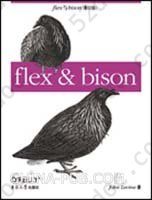注重体验与质量的电子书资源下载网站
分类于: 人工智能 编程语言
简介

FLEX 与 BISON(影印版) 豆 7.9分
资源最后更新于 2020-08-21 15:10:03
作者:John Levine
出版社:东南大学出版社
出版日期:2010-01
ISBN:9787564119324
文件格式: pdf
标签: flex bison 编译原理 计算机 编程 词法分析 C unix
简介· · · · · ·
如果你需要分析或处理Linux或Unix中的文本数据,这本有用的书籍就向你讲解了如何使用flex和bison迅速解决问题。《flex与bison》被期待已久,是经典O’Reilly系列书籍《lex & yacc》的续篇。在原书出版以来的近20年中,flex和bison已被证明比原来的Unix工具更可靠、更强大。
《flex与bison》一书涵盖了Linux和Unix程序开发中相同的重要核心功能,以及一些重要的新主题。你会找到适用于新手的修订教程和适用于高级用户的参考资料,以及对每个程序的基本用法的解释,并且运用它们创建简单、独立的应用程序。有了《flex与bison》,你会发现这些灵活的工具提供的广泛用途。
目录
Preface
1. Introducing Flex and Bison
Lexical Analysis and Parsing
Regular Expressions and Scanning
Our First Flex Program
Programs in Plain Flex
Putting Flex and Bison Together
The Scanner as Coroutine
Tokens and Values
Grammars and Parsing
BNF Grammars
Bison’s Rule Input Language
Compiling Flex and Bison Programs Together
Ambiguous Grammars: Not Quite
Adding a Few More Rules
Flex and Bison vs. Handwritten Scanners and Parsers
Exercises
2. Using Flex
Regular Expressions
Regular Expression Examples
How Flex Handles Ambiguous Patterns
Context-Dependent Tokens
File I/O in Flex Scanners
Reading Several Files
The I/O Structure of a Flex Scanner
Input to a Flex Scanner
Flex Scanner Output
Start States and Nested Input Files
Symbol Tables and a Concordance Generator
Managing Symbol Tables
Using a Symbol Table
C Language Cross-Reference
Exercises
3. Using Bison
How a Bison Parser Matches Its Input
Shift/Reduce Parsing
What Bison’s LALR(1) Parser Cannot Parse
A Bison Parser
Abstract Syntax Trees
An Improved Calculator That Creates ASTs
Literal Character Tokens
Building the AST Calculator
Shift/Reduce Conflicts and Operator Precedence
When Not to Use Precedence Rules
An Advanced Calculator
Advanced Calculator Parser
Calculator Statement Syntax
Calculator Expression Syntax
Top-Level Calculator Grammar
Basic Parser Error Recovery
The Advanced Calculator Lexer
Reserved Words
Building and Interpreting ASTs
Evaluating Functions in the Calculator
User-Defined Functions
Using the Advanced Calculator
Exercises
4. Parsing SQL
A Quick Overview of SQL
Relational Databases
Manipulating Relations
Three Ways to Use SQL
SQL to RPN
The Lexer
Scanning SQL Keywords
Scanning Numbers
Scanning Operators and Punctuation
Scanning Functions and Names
Comments and Miscellany
The Parser
The Top-Level Parsing Rules
SQL Expressions
Select Statements
Delete Statement
Insert and Replace Statements
Update Statement
Create Database
Create Table
User Variables
The Parser Routines
The Makefile for the SQL Parser
Exercises
5. A Reference for Flex Specifications
Structure of a Flex Specification
Definition Section
Rules Section
User Subroutines
BEGIN
C++ Scanners
Context Sensitivity
Left Context
Right Context
Definitions (Substitutions)
ECHO
Input Management
Stdio File Chaining
Input Buffers
Input from Strings
File Nesting
input()
YY_INPUT
Flex Library
Interactive and Batch Scanners
Line Numbers and yylineno
Literal Block
Multiple Lexers in One Program
Combined Lexers
Multiple Lexers
Options When Building a Scanner
Portability of Flex Lexers
Porting Generated C Lexers
Reentrant Scanners
Extra Data for Reentrant Scanners
Access to Reentrant Scanner Data
Reentrant Scanners, Nested Files, and Multiple Scanners
Using Reentrant Scanners with Bison
Regular Expression Syntax
Metacharacters
REJECT
Returning Values from yylex()
Start States
unput()
yyinput() yyunput()
yyleng
yyless()
yylex() and YY_DECL
yymore()
yyrestart()
yy_scan_string and yy_scan_buffer
YY_USER_ACTION
yywrap()
6. A Reference for Bison Specifications
Structure of a Bison Grammar
Symbols
Definition Section
Rules Section
User Subroutines Section
Actions
Embedded Actions
Symbol Types for Embedded Actions
Ambiguity and Conflicts
Types of Conflicts
Shift/Reduce Conflicts
Reduce/Reduce Conflicts
%expect
GLR Parsers
Bugs in Bison Programs
Infinite Recursion
Interchanging Precedence
Embedded Actions
C++ Parsers
%code Blocks
End Marker
Error Token and Error Recovery
%destructor
Inherited Attributes ($0)
Symbol Types for Inherited Attributes
%initial-action
Lexical Feedback
Literal Block
Literal Tokens
Locations
%parse-param
Portability of Bison Parsers
Porting Bison Grammars
Porting Generated C Parsers
Libraries
Character Codes
Precedence and Associativity Declarations
Precedence
Associativity
Precedence Declarations
Using Precedence and Associativity to Resolve Conflicts
Typical Uses of Precedence
Recursive Rules
Left and Right Recursion
Rules
Special Characters
%start Declaration
Symbol Values
Declaring Symbol Types
Explicit Symbol Types
Tokens
Token Numbers
Token Values
%type Declaration
%union Declaration
Variant and Multiple Grammars
Combined Parsers
Multiple Parsers
Using %name-prefix or the -p Flag
Lexers for Multiple Parsers
Pure Parsers
y.output Files
Bison Library
main()
yyerror()
YYABORT
YYACCEPT
YYBACKUP
yyclearin
yydebug and YYDEBUG
YYDEBUG
yydebug
yyerrok
YYERROR
yyerror()
yyparse()
YYRECOVERING()
7. Ambiguities and Conflicts
The Pointer Model and Conflicts
Kinds of Conflicts
Parser States
Contents of name.output
Reduce/Reduce Conflicts
Shift/Reduce Conflicts
Review of Conflicts in name.output
Common Examples of Conflicts
Expression Grammars
IF/THEN/ELSE
Nested List Grammar
How Do You Fix the Conflict?
IF/THEN/ELSE (Shift/Reduce)
Loop Within a Loop (Shift/Reduce)
Expression Precedence (Shift/Reduce)
Limited Lookahead (Shift/Reduce or Reduce/Reduce)
Overlap of Alternatives (Reduce/Reduce)
Summary
Exercises
8. Error Reporting and Recovery
Error Reporting
Locations
Adding Locations to the Parser
Adding Locations to the Lexer
More Sophisticated Locations with Filenames
Error Recovery
Bison Error Recovery
Freeing Discarded Symbols
Error Recovery in Interactive Parsers
Where to Put Error Tokens
Compiler Error Recovery
Exercises
9. Advanced Flex and Bison
Pure Scanners and Parsers
Pure Scanners in Flex
Pure Parsers in Bison
Using Pure Scanners and Parsers Together
A Reentrant Calculator
GLR Parsing
GLR Version of the SQL Parser
C++ Parsers
A C++ Calculator
C++ Parser Naming
A C++ Parser
Interfacing a Scanner with a C++ Parser
Should You Write Your Parser in C++ ?
Exercises
Appendix: SQL Parser Grammar and Cross-Reference
Glossary
Index
1. Introducing Flex and Bison
Lexical Analysis and Parsing
Regular Expressions and Scanning
Our First Flex Program
Programs in Plain Flex
Putting Flex and Bison Together
The Scanner as Coroutine
Tokens and Values
Grammars and Parsing
BNF Grammars
Bison’s Rule Input Language
Compiling Flex and Bison Programs Together
Ambiguous Grammars: Not Quite
Adding a Few More Rules
Flex and Bison vs. Handwritten Scanners and Parsers
Exercises
2. Using Flex
Regular Expressions
Regular Expression Examples
How Flex Handles Ambiguous Patterns
Context-Dependent Tokens
File I/O in Flex Scanners
Reading Several Files
The I/O Structure of a Flex Scanner
Input to a Flex Scanner
Flex Scanner Output
Start States and Nested Input Files
Symbol Tables and a Concordance Generator
Managing Symbol Tables
Using a Symbol Table
C Language Cross-Reference
Exercises
3. Using Bison
How a Bison Parser Matches Its Input
Shift/Reduce Parsing
What Bison’s LALR(1) Parser Cannot Parse
A Bison Parser
Abstract Syntax Trees
An Improved Calculator That Creates ASTs
Literal Character Tokens
Building the AST Calculator
Shift/Reduce Conflicts and Operator Precedence
When Not to Use Precedence Rules
An Advanced Calculator
Advanced Calculator Parser
Calculator Statement Syntax
Calculator Expression Syntax
Top-Level Calculator Grammar
Basic Parser Error Recovery
The Advanced Calculator Lexer
Reserved Words
Building and Interpreting ASTs
Evaluating Functions in the Calculator
User-Defined Functions
Using the Advanced Calculator
Exercises
4. Parsing SQL
A Quick Overview of SQL
Relational Databases
Manipulating Relations
Three Ways to Use SQL
SQL to RPN
The Lexer
Scanning SQL Keywords
Scanning Numbers
Scanning Operators and Punctuation
Scanning Functions and Names
Comments and Miscellany
The Parser
The Top-Level Parsing Rules
SQL Expressions
Select Statements
Delete Statement
Insert and Replace Statements
Update Statement
Create Database
Create Table
User Variables
The Parser Routines
The Makefile for the SQL Parser
Exercises
5. A Reference for Flex Specifications
Structure of a Flex Specification
Definition Section
Rules Section
User Subroutines
BEGIN
C++ Scanners
Context Sensitivity
Left Context
Right Context
Definitions (Substitutions)
ECHO
Input Management
Stdio File Chaining
Input Buffers
Input from Strings
File Nesting
input()
YY_INPUT
Flex Library
Interactive and Batch Scanners
Line Numbers and yylineno
Literal Block
Multiple Lexers in One Program
Combined Lexers
Multiple Lexers
Options When Building a Scanner
Portability of Flex Lexers
Porting Generated C Lexers
Reentrant Scanners
Extra Data for Reentrant Scanners
Access to Reentrant Scanner Data
Reentrant Scanners, Nested Files, and Multiple Scanners
Using Reentrant Scanners with Bison
Regular Expression Syntax
Metacharacters
REJECT
Returning Values from yylex()
Start States
unput()
yyinput() yyunput()
yyleng
yyless()
yylex() and YY_DECL
yymore()
yyrestart()
yy_scan_string and yy_scan_buffer
YY_USER_ACTION
yywrap()
6. A Reference for Bison Specifications
Structure of a Bison Grammar
Symbols
Definition Section
Rules Section
User Subroutines Section
Actions
Embedded Actions
Symbol Types for Embedded Actions
Ambiguity and Conflicts
Types of Conflicts
Shift/Reduce Conflicts
Reduce/Reduce Conflicts
%expect
GLR Parsers
Bugs in Bison Programs
Infinite Recursion
Interchanging Precedence
Embedded Actions
C++ Parsers
%code Blocks
End Marker
Error Token and Error Recovery
%destructor
Inherited Attributes ($0)
Symbol Types for Inherited Attributes
%initial-action
Lexical Feedback
Literal Block
Literal Tokens
Locations
%parse-param
Portability of Bison Parsers
Porting Bison Grammars
Porting Generated C Parsers
Libraries
Character Codes
Precedence and Associativity Declarations
Precedence
Associativity
Precedence Declarations
Using Precedence and Associativity to Resolve Conflicts
Typical Uses of Precedence
Recursive Rules
Left and Right Recursion
Rules
Special Characters
%start Declaration
Symbol Values
Declaring Symbol Types
Explicit Symbol Types
Tokens
Token Numbers
Token Values
%type Declaration
%union Declaration
Variant and Multiple Grammars
Combined Parsers
Multiple Parsers
Using %name-prefix or the -p Flag
Lexers for Multiple Parsers
Pure Parsers
y.output Files
Bison Library
main()
yyerror()
YYABORT
YYACCEPT
YYBACKUP
yyclearin
yydebug and YYDEBUG
YYDEBUG
yydebug
yyerrok
YYERROR
yyerror()
yyparse()
YYRECOVERING()
7. Ambiguities and Conflicts
The Pointer Model and Conflicts
Kinds of Conflicts
Parser States
Contents of name.output
Reduce/Reduce Conflicts
Shift/Reduce Conflicts
Review of Conflicts in name.output
Common Examples of Conflicts
Expression Grammars
IF/THEN/ELSE
Nested List Grammar
How Do You Fix the Conflict?
IF/THEN/ELSE (Shift/Reduce)
Loop Within a Loop (Shift/Reduce)
Expression Precedence (Shift/Reduce)
Limited Lookahead (Shift/Reduce or Reduce/Reduce)
Overlap of Alternatives (Reduce/Reduce)
Summary
Exercises
8. Error Reporting and Recovery
Error Reporting
Locations
Adding Locations to the Parser
Adding Locations to the Lexer
More Sophisticated Locations with Filenames
Error Recovery
Bison Error Recovery
Freeing Discarded Symbols
Error Recovery in Interactive Parsers
Where to Put Error Tokens
Compiler Error Recovery
Exercises
9. Advanced Flex and Bison
Pure Scanners and Parsers
Pure Scanners in Flex
Pure Parsers in Bison
Using Pure Scanners and Parsers Together
A Reentrant Calculator
GLR Parsing
GLR Version of the SQL Parser
C++ Parsers
A C++ Calculator
C++ Parser Naming
A C++ Parser
Interfacing a Scanner with a C++ Parser
Should You Write Your Parser in C++ ?
Exercises
Appendix: SQL Parser Grammar and Cross-Reference
Glossary
Index








